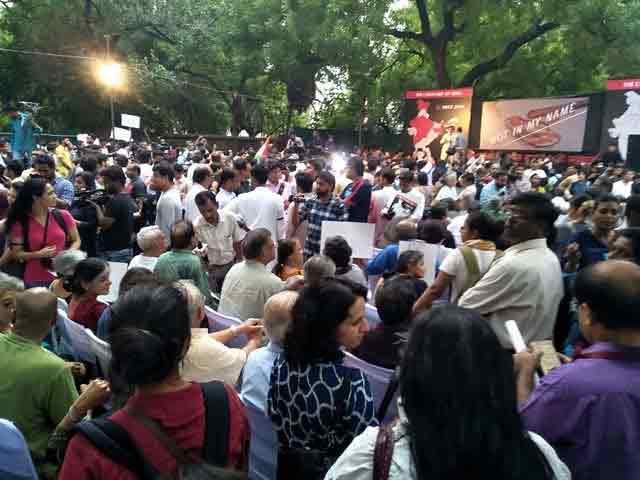
On 22 June evening 15-year-old Junaid was lynched to death near Ballabhgarh on a Mathura-bound train from Delhi. Junaid and his brothers were returning home after doing some shopping for Eid in Old Delhi. But the festivity of Eid was not for Junaid’s family in Khandawali. The spate of lynchings that had begun in 2015 with the killing of Abdul Ghafoor Quraishi in Nagaur and Mohammad Akhlaque in Dadri has now become almost an everyday national phenomenon. The rumours of beef consumption, cattle-theft and cow slaughter are no longer necessary as a pretext. Zafar Khan was killed because he had protested against the photography of women defecating in the open. Junaid was killed, as poet Madan Kashyap has written so evocatively, simply because he was Junaid, a young Muslim boy in Modi’s ‘New India’.
The lynching of young Junaid struck a chord with every sensitive Indian, and on 28 June India witnessed largely spontaneous demonstrations in several cities including Delhi, Mumbai, Kolkata, Chennai, Bengaluru, Hyderabad and Patna. London and Toronto also joined in. The demonstrators held placards and banners proclaiming ‘Not In My Name’, giving voice to the deeply felt disquiet and anguish of common Indians across the country and also among the diaspora. The next day Modi had to break his silence on the issue. Speaking on the occasion of the centenary of the foundation of the historic Sabarmati Ashram, he invoked Gandhi to say that Gandhi wouldn’t have approved of this violence. Modi’s belated words of cosmetic condemnation however did not deter the cow terrorists who feel empowered and emboldened under the current dispensation to beat up and kill people at will. Indeed, even as Modi invoked Gandhi in Ahmedabad, in Ramgarh in BJP-ruled Jharkhand Bajrang Dal and BJP activists lynched meat trader Alimuddin Ansari to death. Only a day before, dairy farmer Usman Ansari was grievously injured and his house set on fire by a mob of cow thugs in Deori block in neighbouring Giridih district.
The lynchings are not isolated instances happening randomly. There is a very clear socio-political context to all these incidents. The politics of the cow and the bogey of the so-called ‘pink revolution’ were invoked by none other than Narendra Modi in his 2014 campaign. BJP-ruled governments are giving the whole issue political legitimacy by banning slaughterhouses and cattle-trade. When a key accused in the Akhlaque murder case died, BJP leaders wrapped his body in the national tricolour. It is this relentless politicisation of the cow and the patronage and impunity extended to the cow terrorists that explain the present surge in the phenomenon of cow thuggery and mob lynching.
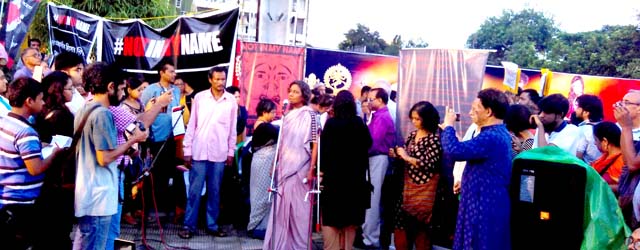
While Modi feels compelled to speak occasionally against fake cow protectors – after Una he had even asked these ‘fake protectors’ to kill him and spare his ‘Dalit brothers’ – the pro-BJP media and BJP intellectuals are busy ridiculing the protests, calling them selective, hypocritical and politically motivated. Amit Shah said there were more lynchings before Modi came to power and yet the protesters who had kept quiet then are now attacking Modi. A factual compilation of cases of lynching since 2010 to 25 June 2017 done by IndiaSpend.com shows that of the 63 cases, 61 or 97% happened after Modi came to power, 25 of them in 2016 and 20 till 25 June 2017 which clearly shows the escalation in recent months. In fact two more cases were reported from Jharkhand alone since June 25.
Apart from trying to negate the alarming rise in cases of mob lynching, something which has become the ‘new normal’ in Modi’s ‘new India’ by fudging figures, BJP leaders and intellectuals are also trying to discredit the protests by calling them selective and hypocritical. Their argument is that people protesting against the Ballabhgarh train lynching are selectively suppressing the case of lynching of DSP Ayub Pandith in front of Jamia Masjid in downtown Srinagar. The fact is that the #NotInMyName protests had clearly condemned all cases of lynching including that of DSP Ayub Pandith but the focus was clearly on the most recent and shocking case of killing of Hafiz Junaid. Ironically, the same BJP intellectuals who are accusing the #NotInMyName protesters of downplaying the brutal killing of DSP Ayub Pandith had described J&K police of being terrorists in police uniform with their heart being with Pakistan when some students were beaten by the police in the Srinagar NIT campus.
While pro-BJP TV channels went to the extent of trying to discredit the protests as Pakistan-inspired defamation of India, noted columnist and BJP intellectual and Rajya Sabha MP Swapan Dasgupta described the protests as an expression of ‘rootless cosmopolitanism’, even an act of ’emotional treachery’! This is almost like Asaram Bapu telling after the December 2012 Delhi rape that rocked the nation that Nirbhaya shouldn’t have resisted the rape, and treat the rapists as her brothers and beg for her life. Lynching is only a legal offence for the BJP ideologues; the politics of the cow that triggers most cases of lynching is however an article of faith in ‘cultural nationalism’ and those challenging this lexicon of ‘cultural nationalism’ stand guilty of ’emotional treachery’ and ‘rootless cosmopolitanism’. Mob violence is a tested and trusted method of the Sangh brigade whether it is employed in communal riots and genocides, demolition of the Babri Masjid or in the ongoing acts of cow terrorism and BJP intellectuals are willing to play the role of ‘rooted’ cheerleaders for these acts of unconscionable violence.
Campaign In Delhi Against Mob Lynching
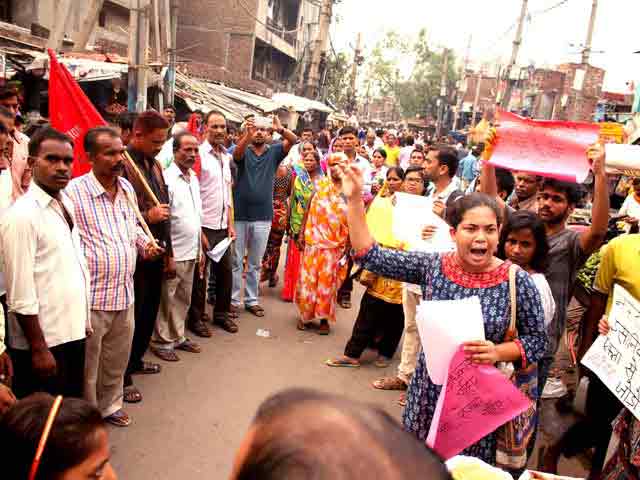 The CPI(ML), All India People’s Forum, AISA, AICCTU, NTUI, Building Workers’ Union, AIPWA, and Delhi Nagrik Manch together launched a pledge-taking campaign all over Delhi to reaffirm Constitutional values and rebuff hate-mongering propaganda and mob-lynching. The campaign, which began on 15 July, will culminate on the country’s Independence Day, 15 August.
The CPI(ML), All India People’s Forum, AISA, AICCTU, NTUI, Building Workers’ Union, AIPWA, and Delhi Nagrik Manch together launched a pledge-taking campaign all over Delhi to reaffirm Constitutional values and rebuff hate-mongering propaganda and mob-lynching. The campaign, which began on 15 July, will culminate on the country’s Independence Day, 15 August.
As part of the campaign, activists and concerned citizens are speaking to individuals and groups of people in Delhi’s various settlements, slum clusters and streets, urging them to recognize the violent hate-mongering campaigns that seek to ‘divide and rule’ people’s unity.
The campaign urges every citizen to pledge to uphold the values of humanity, democracy, diversity and dissent enshrined in India’s Constitution, and resist attempts to foment hatred and mob violence against vulnerable communities.
Crackdown On Peace March: Nitish’s Bihar Government Behaves Like Modi’s
Hundreds of people gathered for an ‘Aman March’ (Peace March) on 17 July 2017 in Bihar Sharif, Nalanda, Bihar against mob lynchings and the Amarnath killings. But the local administration and police unleashed a lathicharge and crackdown on a peaceful demonstration.
The demonstration had been called by the Insaf Manch (an organization known for its successful activism and advocacy for Muslim youth falsely framed in terror cases). It was a bannerless and silent demonstration, following the lead of the Not In My Name protests that are taking place all over India.
The CPI (ML) and Insaf Manch both sent enquiry teams to enquire into the incident. The State level CPI (ML) team included Legislative Party leader Mahboob Alam and CCM Saroj Chaubey. The Insaf Manch team comprised Suraj Kumar Singh, Mohd Fahad Jama, Mohd Ehtasham Ahmad, Aslam Rahmani, Sunil Kumar, Surendra Ram, Madhusudan Sharma, Pal Bihari Lal, Naval Pasad and others. The team spoke to the SDM and enquired why the program denied permission. The officer responded by asking what was the aim of such a program in Bihar Sharif as there has been no lynching incident here! He openly said that all the people in the march were trouble-makers and had come to create riots under the ‘suspicious’ Insaf Manch banner. Clearly the administration was badly prejudiced against the minority community. The team found that names in the FIR have been wilfully added with no basis. Names like those of Akhlaq and Sogra College Principal Mohd Sagir Ujjama are in the FIR who were either not present on the spot or had nothing to do with the march.
The SDM Sudhir Kumar issued the letter denying permission for the program one hour before the start of the program – when hundreds of people had already gathered for it. The people had not even advanced 30 metres when they were stopped by the police. The protesters were ready to court arrest but the administration did not arrest them at that time. The meeting continued at that place for one hour. Just then the administration arrested 27 other Muslim young men and the gathering demanded their release. The Hindustan daily, reporting on the incident, pointed out that the protesters offered to court arrest themselves in exchange of release of arrested teenagers. But the officials deliberately did not listen to their demands. After a long wait they offered to be arrested and tried to sit in a bus brought to the spot by the administration. But the police officers did not allow them to sit in the bus, instead ordered them to remain on spot. All people obeyed this too and remained standing on the road. Senior officials slowly disappeared from the protest site and in a short while the police started lathicharging the silent protesters. (These details have been reported in the Hindustan dated 18 July 2017).
Many CPI(ML) activists along with dozens of others are seriously injured and 53 people have been arrested. Local CPI(ML) activists Maksudan Sharma, Ramdas Akela, and Manmohan were also injured and arrested, as well as Rina Devi, Pal Bihari Lal, Kishori Sav and Sarfaraz Khan who had also helped organize the Peace March.
The next day, there was a concerted campaign of vilification of the peaceful protest in the local media also. In these, the protesters as well as Insaf Manch organisers who had informed the police of the planned demonstration, were demonized as breakers of the peace and inciters of communal disturbance.
The police claimed that they denied permission for the Aman March because it could disturb the peace – but if such a gathering was inherently violent or unruly, how come the gathering held a peaceful mass meeting for over an hour, until disrupted by the police?
One deliberately false media report in the Rashtriya Sahara claimed that the Aman March procession was being held in ‘reply’ to a Bajrang Dal programme of ‘Langot Arpan’ which was held in town on 15 July. It is to be noted that the administration (under CM Nitish Kumar) allowed the Bajrang Dal’s ‘Langot Arpan’ event which was a display of militaristic strength by a Hindutva outfit with a history of violence – but denied permission for a silent peace march against communal violence!
This newspaper described the participants of the Peace Procession as ‘upadravi’ (miscreants). Another paper Prabhat Khabar claimed – in what is entirely a fake news – that the protesters indulged in two rounds of firing, even as the same paper in the same paragraph has reported the statement of the Superintendent of police that no firing took place. The Prabhat Khabar termed the Insaf Manch organisers as ‘ringmasters’ of the incident! Another newspaper ‘Aaj’ commended the district administration for adopting a ‘zero tolerance’ approach and denying permission for the Peace March, which would have engulfed the whole town in flames if allowed!
Only the Hindustan daily reported accurately that the administration was entirely responsible for the incident, since it needlessly arrested 25 teenagers and refused to concede the demonstrators’ peaceful demand that they be released, and that senior officials instead simply left the place.
Various Protests Against Mob Lynching and Communal Violence
On July 14, 2017, thousands held a dharna in Mau, Uttar Pradesh organized by the Mau Nagrik Manch, with the slogan ‘Mau United Against Mob Lynching’. On the same day, the CPI(ML) Liberation held a procession in Naihati, West Bengal against the recent communal incidents in the state, stressing the need for peace, unity and harmony.
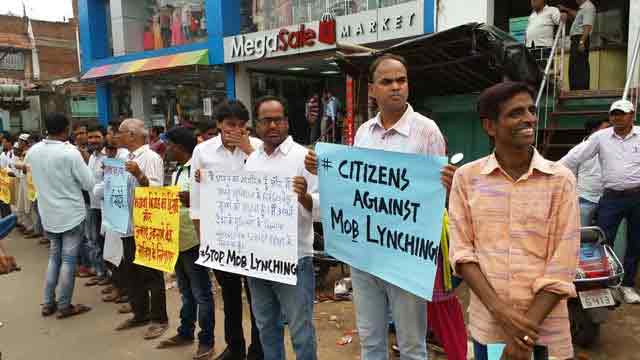 A Sadbhavna March (March for Goodwill) was held in Ranchi on 6 July calling for peace against the growing incidents of mob lynching, including the killing of teenager Junaid in Ballabhgarh and Alimuddin Ansari in Ramgarh, Jharkhand on 29 June.
A Sadbhavna March (March for Goodwill) was held in Ranchi on 6 July calling for peace against the growing incidents of mob lynching, including the killing of teenager Junaid in Ballabhgarh and Alimuddin Ansari in Ramgarh, Jharkhand on 29 June.
On 7 July, thousands of people in Giridih, Jharkhand, organised a 1.5 kilometer long Human Chain to raise their voice against communal mob lynchings in the State and in the country. The Human Chain extended on both sides of the road from Maulana Azad Chowk to Bada Chowk Station Road for about two hours from 2.30-4.30 pm. This event was organized by Awami Insaf Manch and Sajha Manch together.
Massive Left Rally In Kolkata Against Communal Violence
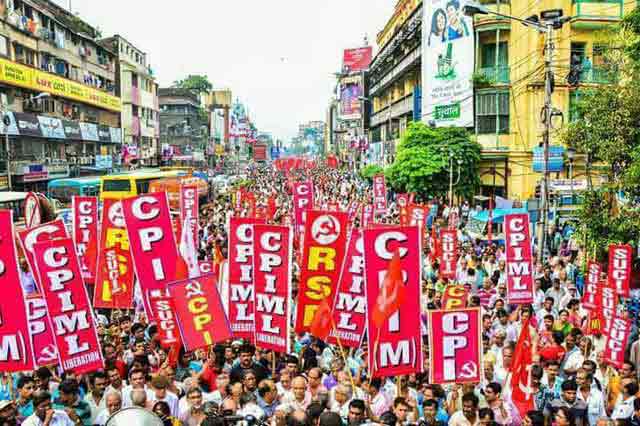
Thousands of people marched with colourful banners and posters, under the banner of Left parties in Kolkata on 12 July, to reaffirm and assert West Bengal’s legacy of communal harmony and protest against recent incidents of communal violence at Basirhat, North 24 Parganas.
The march was organised by 20 political parties including CPI, CPI(M), CPI (ML-Liberation), SUCI (C), and other Left parties, as well as some non-Left parties including RJD, and WB Janata Dal. The procession marched from Mahajati Sadan through Chittaranjan Avenue and Chowringhee to Rani Rasmoni Avenue.
